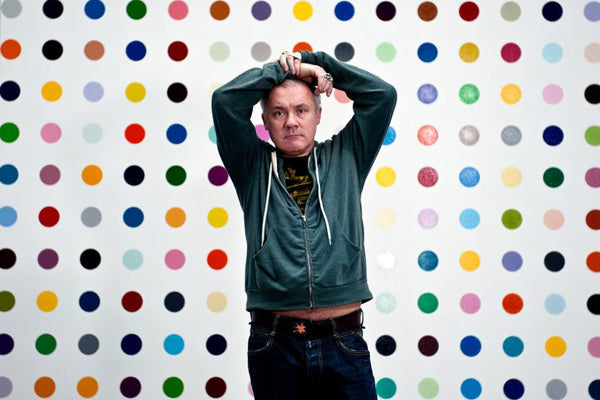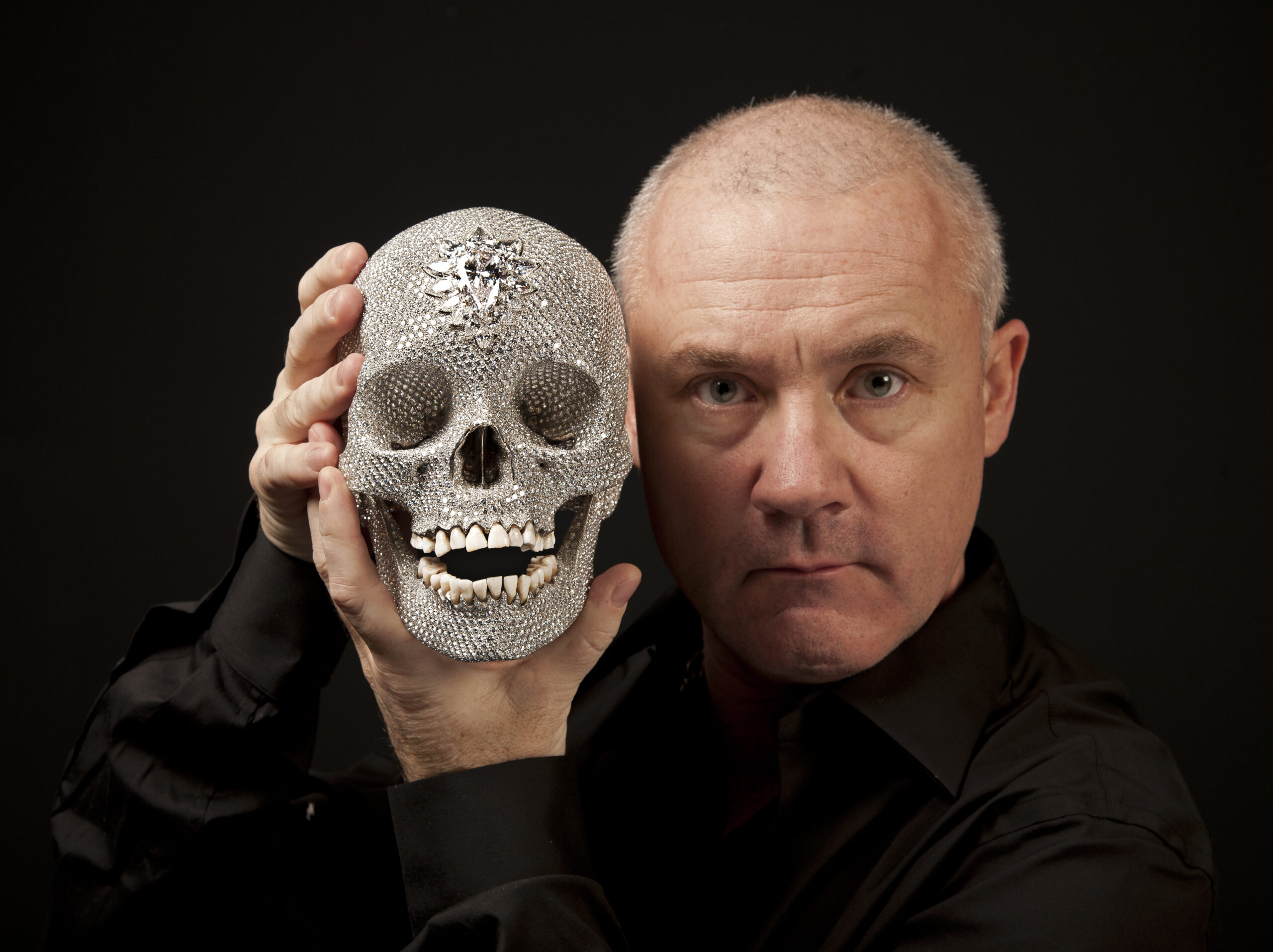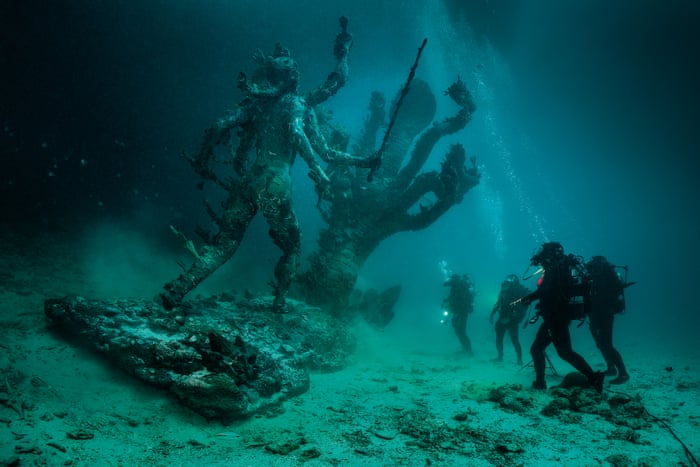Damien Hirst’s career has spanned over three decades, during which he has continually redefined the visual language of contemporary art. From his infamous vitrines and spot paintings to his intricate butterfly collages and diamond-encrusted skulls, Hirst’s imagery has evolved dramatically—yet it has always remained rooted in a fascination with life, death, beauty, and belief. This blog explores the key phases in Hirst’s career through the changing imagery of his work, reflecting both personal shifts and broader dialogues in contemporary art.
Beginnings: Conceptual Brutality and Biological Truths
Hirst first came to prominence in the early 1990s as the leading figure of the Young British Artists (YBAs). His breakthrough came with The Physical Impossibility of Death in the Mind of Someone Living (1991), a tiger shark suspended in formaldehyde. This iconic work established several recurring themes in Hirst’s oeuvre: the confrontation with mortality, the clinical aesthetic of scientific display, and a reliance on shock as a means to provoke reflection.

During this period, Hirst employed imagery associated with biology, dissection, and decay. His series of vitrines featuring preserved animals—cows, sheep, and sharks—echoed the visual language of medical museums. Works like Mother and Child Divided (1993) presented bisected animals in glass cases, inviting viewers to witness the fragility of life from a sterile, almost spiritual distance. These early works cemented Hirst’s place as a provocateur, but they also revealed his deeper engagement with the philosophical tension between the sacred and the scientific.
The Pharmaceutical and Minimal Aesthetic
Alongside his more visceral work, Hirst began developing his Spot Paintings—geometric arrays of colored dots arranged on white backgrounds. Seemingly detached from emotion or narrative, these works were born from Hirst’s interest in pharmacology and the sterile order of science. The spots, named after chemical compounds, suggest both precision and anonymity. They embody a minimalist logic that contrasts with the organic chaos of his vitrines, yet they too reflect on human attempts to control mortality—this time through medicine rather than religion or art.
This phase marked a shift in Hirst’s imagery from confrontational to controlled. The clean aesthetic of the Spot Paintings aligned him with a more formal, almost Modernist lineage, and they were crucial in establishing his commercial viability. However, despite their apparent neutrality, these works retained an undercurrent of existential unease, subtly pointing to the pharmaceutical industry's role in managing life and death.

Romanticism, Religion, and the Butterfly Series
In the 2000s, Hirst’s imagery began to shift again—this time embracing beauty and symbolism more overtly. His butterfly series, which began with the Kaleidoscope Paintings, used real butterfly wings arranged in mandala-like patterns. These works combined the spiritual iconography of stained-glass windows with the natural beauty and delicacy of butterflies, creatures that have long symbolized the soul and transformation.
Here, Hirst moved away from the literal representations of death toward a more poetic meditation on mortality and transcendence. The butterflies, while undeniably beautiful, also underscore the violence of their making—pinned, arranged, and ultimately sacrificed for the sake of art. This tension between beauty and brutality is central to Hirst’s practice and adds layers of complexity to his imagery in this period.
At the same time, Hirst increasingly employed overtly religious motifs. Works like The Sacred Heart of Jesus (2005) merged Catholic iconography with anatomical detail, blurring the boundaries between spiritual belief and scientific knowledge. The imagery became richer, denser, and more symbolically loaded—inviting viewers to interpret meaning through layers of visual and cultural reference.

The Diamond Skull and the Luxury of Immortality
Perhaps the most infamous image of Hirst’s mid-career is For the Love of God (2007)—a platinum cast of a human skull encrusted with over 8,000 diamonds. This piece embodies the ultimate convergence of themes that Hirst had explored for years: death, value, beauty, and belief. On one level, it is a memento mori for the contemporary age, echoing vanitas traditions of the Renaissance. On another, it is a reflection on art as a commodity—art that literalizes the equation between capital and legacy.
The skull represents the apex of Hirst’s interest in the iconography of death, now rendered with the opulence of luxury goods. It also signals a broader evolution in his imagery—from medical realism and minimalist abstraction to theatrical spectacle and pop-infused symbolism.

The Veil Paintings and the Return to Painting
By the late 2010s, Hirst returned to more traditional modes of painting, notably through the Veil Paintings series. These works feature thickly impastoed surfaces with gestural, pointillist patterns. Visually lush and abstract, they mark a significant departure from the calculated minimalism of the Spot Paintings. The imagery here is less conceptual and more intuitive—concerned with texture, color, and emotional resonance.
The Veil Paintings suggest a maturation in Hirst’s practice, one that embraces the act of painting as a form of direct expression. While death remains a constant subtext, these works focus more on vitality and the act of creation itself.

Treasures from the Wreck and the Myth-Making Turn
In 2017, Hirst unveiled Treasures from the Wreck of the Unbelievable, a vast exhibition in Venice featuring fabricated artifacts from a fictional ancient shipwreck. The imagery here drew from global mythologies, ancient civilizations, and pop culture mashups. Encrusted statues, hybrid creatures, and Disney characters rendered in bronze revealed a playful, operatic imagination at work.

This project marked a late-career pivot toward narrative and spectacle. The imagery was intentionally deceptive, raising questions about authenticity, history, and the role of the artist as myth-maker. It also signaled Hirst’s ambition to create a Gesamtkunstwerk—a total work of art that fuses storytelling, fabrication, and fine art into one immersive experience.
A Visual Language in Flux
Damien Hirst’s career is a study in visual transformation. From animal carcasses and sterile pharmaceuticals to glittering skulls and mythic sculptures, his imagery has evolved alongside shifts in both cultural context and personal introspection. Yet throughout his career, certain core obsessions have remained: the fragility of life, the inevitability of death, the power of belief, and the illusion of permanence.
Hirst’s evolving imagery reflects not only the trajectory of a single artist but also the wider developments in contemporary art—from conceptualism and postmodern irony to the renewed interest in craft, narrative, and emotion. Whether confronting the viewer with unsettling realism or dazzling beauty, Hirst’s work continues to provoke, question, and mesmerize.
Discover original Damien Hirst signed prints for sale and contact our New York and London galleries via info@guyhepner.com for current availabilities. Looking to sell? Find out how to sell Damien Hirst prints with our teams.

